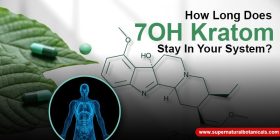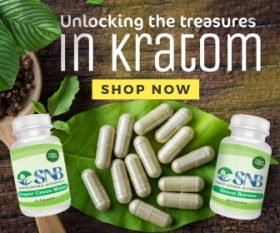Do you know there are over 500 genera and 6000 species of tropical trees and shrubs in the universe? Amongst them, lie Kratom and Matcha plants.
Kratom is having a moment. Belonging to the Coffee family, the tropical evergreen tree has become the latest sensation of the century with its origins tracing back to folklore. No wonder, why it forms the crux of a billion-dollar industry today.
Table of Contents
Likewise, Matcha is another superman of the botanical world. It is a powdered green tea belonging to the Theaceae family of flowering plants. Today, the global matcha market is valued at approximately USD 1.63 billion in 2018, with expectations to grow at a CAGR of 4.7% during the forecast period.
Both Kratom and Matcha were deemed staple ingredients in the Asian traditional ceremonies and religious rituals. Over the years, people realized that both these plants had a lot more to offer besides their capturing looks.
With the similarities in their uses and benefits, it only makes sense why people tend to confuse the two or compare one with the other. Although both have seamlessly integrated well into the beverage industry, the truth is there are quite a lot of differences between the two.
Let’s unveil all the features that unite as well as set them apart.
What is Kratom?
Have you ever consumed Kratom and noticed the effects strikingly resemble coffee?
Well, both Kratom and coffee are interrelated and belong to the same plant family, i.e., Rubiaceae.
Also called Mitragayna Speciosa in the scientific context, the plant comes in various strain types depending on the regions they grow and thrive in. Kratom is available in three natural (Red, Green, and White) vein colors and one man-made (Yellow).


What is Matcha?
Matcha is the powdered version of green Tea, indigenous to China and Japan. As such, it is part of the same family all tea trees belong to, Camellia Sinensis. Basically, Matcha is a type of unfermented green tea that is steamed, dried, and crushed. On the other hand, if you choose to partially ferment or fully ferment it, you will get oolong tea and black Tea, respectively.
Matcha is much sought-after for its simulative, and mind relaxing properties. Besides, it boasts anti-oxidizing properties and is believed to help shed those extra pounds from the body.


The Similarities
1. Chemistry
First and foremost, Kratom and Matcha share a great resemblance pharmacologically. The chemical composition of both substances is dominated by alkaloids. In fact, this characteristic stands unanimous in the entire plant world. However, the type of alkaloids varies for each plant (to be discussed below).
2. Benefits
Have you ever had a cup of Kratom Tea or Matcha and were absolutely awed with the impact? Despite their distinct flavor, taste, and aroma, both guarantee to render an unforgettable experience. Besides, one can find a host of tempting flavors of both Kratom and Matcha for sale online.
Customers vouch for the miraculous all-healing virtues of Kratom. It is a favorite among buyers worldwide for its soothing properties, tantalizing sensations, and the ability to ward off fatigue. Even though these effects vary from one kratom strain to another, kratom powder mixed in your preferred beverage is the way to go for mood-lifting if you have had a bad or hectic day.
Likewise, Matcha lovers too speak highly of its anti-fatigue powers. They simply rave its simulative and mood-enhancing benefits that help to improve focus, and productivity while surrounding the user with an aura of positivity.
3. Preparation and Uses
Today, the most in-demand and sought-after supplement form for both Kratom and Matcha is its powdered version.
In the ancient era, the local field and mine workers were habitual of nibbling the raw fresh or dried leaves to benefit and extract the maximum alkaloid content directly. As time and technology progressed, people invented innovative ways of consuming Kratom. Today, the leaves are dried, processed, and crushed into various powders, extracts, capsules, or gummies to be sold all across the globe. Fans love mixing it with their favorite beverages, meals, or desserts to mask the bitter taste.
Matcha is manufactured in a similar manner. However, the cultivation is a bit technical and involves a little more investment of time, energy, and money to grow it under the shade – the rest of the process is the same.
Just as in the case of Kratom, there are Matcha innovations and alternatives making rounds. For instance, a Matcha latte prepared by mixing the same crushed powder with hot milk is a big hit. In addition, you can find other flavored drinks and products like mochi ice cream and soba noodles.
The Differences
1. Active Chemical Compounds
Matcha’s impact is driven by the two major compounds, caffeine and theanine. Caffeine, also present in coffee, works wonders to help us stay focused, alert, awake, and concentrated, while theanine helps ward off uneasiness and improves mood. Besides these two there lies another active ingredient, epigallocatechin gallate, an antioxidant.
On the other hand, the two active ingredients in Kratom indole alkaloids, Mitragynine and 7-Hydroxymitragyniner, alongside other compounds. These are responsible for reacting with the mu-opioid receptors in the brain to relieve all the discomfort and prevail peace and tranquility.
It is also worth mentioning that the impact of Kratom is much more pronounced than Matcha as the latter fails to produce that level of intense simulation.
2. Dosage
Kratom is an effective yet tricky substance that must be used with caution and in limited quantities. Beginners are suggested to start with 0.5 grams and gradually make their way up to 2 grams, whereas veterans with a developed tolerance can take between 3 to 5 grams.
On the flip side, consumption of Matcha is safe compared to Kratom, and people can consume as much as 6 cups in a day. This would approximate taking 120 to 240 mg of theanine and 150mg of caffeine.
3. Safety
Given the limited research, the safety and efficacy of Kratom remain unclear. In 2019, the Food and Drug Administration issued a statement not approving its use for “treating any medical condition”. The concern arises mainly due to its addictive nature that can prove detrimental to health in the long run. In the short term, excess use can trigger nausea, diarrhea, hallucinations, dehydration, tremors, and so on.
On the other hand, Match is touted as safe and incredibly beneficial. It comes as no surprise that medical practitioners highly recommend the herb to combat irritability and obesity. However, the benefits do not allow its abuse of any sort as it can adversely affect your appetite and cause stomach issues.
4. Legality Status
Given the lack of research and its controversial safety status, Kratom is declared a controlled substance in 16 countries including Denmark, Lithuania, Poland, Latvia, Romania, and Sweden. In 2014, the FDA banned its import and manufacturing as a dietary supplement along with imposing several other restrictions in the U.S.
5. Addiction
Despite its benefits, there is no denying that Kratom is classified as a drug of concern due to its addictive nature, and withdrawal symptoms. On the other hand, Matcha does not induce drug independence unless consumed more than eight times a day or for more than two years.
6. Origins
The spectacular islands of Indonesia, Malaysia, Myanmar, and Papua New Guinea are home to exotic kratom trees. Here the plants have been thriving and flourishing for centuries
On the flip side, archeologists believe that the Chinese were the first nation to invent and consume tea. The cultivation of the tea plant was first traced in the ancient tomb of Emperor Jing as early as the 2nd Century. Gradually, the tradition made its way to Japan, who are believed to be the true masters, and introducers of powdered tea during Emperor Tang’s dynasty. The Buddhist communities carried forward the legacy as part of their sacred rituals before it gained momentum in other parts of the world.
Even after several thousand years down the lane, green tea forms an integral part of the daily regimen.
7. Biology
The towering Kratom tree blooms amidst the lush, steep lands, mineral-rich soil, and tropical climate. They acquire a height of 80 feet and are complemented by round inflorescence and attractive leaves.
On the other hand, like other tea plants, Matcha is an evergreen shrub bearing beautiful white flowers. After the plants reach a height of 3 meters, the leaves are plucked and processed to make Matcha whereas the flower seeds are utilized to prepare cooking oil.
How To Mix Matcha and Kratom?
Are you one of those adventurous peeps curious to discover the thrill or joy of combining the two? Here is how you can do it:
- Toss and Wash: Measure the amounts of each and thoroughly mix them in a bowl. Add a liquid or an enhancer, have it in a spoon and wash it down with your favorite drink.
- Kratom-Matcha Tea: A lot of people love brewing this refreshing tea. Bring a pot of water to boil and add measured doses of each ingredient alongside a sweetener. Strain and sup.
- Matcha Kratom Smoothie; Proponents swear by the delicacy, creamy texture and mesmerizing impact of a pineapple, banana, berry, almond or soy milk smoothie infused with kratom and matcha.
Can Kratom-Matcha Combination Get You High?
Kratom-matcha mixture is believed to be safe ONLY when the two are mixed in small or limited doses. Too much of either substance can make one high and trigger side effects. The key is to measure both in the exact desired amounts and blend well. Also, if you are sensitive or allergic to any of these substances, then it’s best to avoid them.
Pro-Tip: Go for experimentation and trial and error by varying the dosages or methods to come up with just the right combination excluding the intoxicating high.
Does Kratom-Matcha Combo Build Tolerance?
Do you feel addicted to the Kratom-matcha mixture and just can’t help it? The only legit concern arising is, whether it leads to dependence or not.
In light of a recent 2019 Malaysian Study Substance Use Disorder Related To Kratom, our bodies cannot handle high doses of Kratom as it can trigger a host of perilous hazards. Key experimentations of the study concluded that “regular and chronic (>3 glasses daily) kratom tea/juice consumption was associated with kratom use disorder, severe kratom dependence, and moderate withdrawal”.
Likewise, prolonged use of Matcha can adversely impact our health in the long run. Its regular consumption is deemed safe only till up to two years or when used as a mouthwash. And, use beyond the said period or more than 8 cups a day is considered abusive and so can trigger a host of side effects owing to the caffeine content. These can vary from being mild to severe.
Final Thoughts
Unless you have been living under a rock, you must have been familiar with the dominance of Kratom and Matcha in the herbal world.
Matcha and Kratom are two unique leaf-derived products. As such, it is worth comparing the two given their similar nature, origins, production, and overlapping uses- with an equal share of differences.
Both the plants feature beneficial alkaloid-induced effects that are much more potent than regular Tea. As such, they form an excellent ingredient to add to your daily repertoire providing euphoria, and enthusiasm to get in the flow. Or how about trying a kratom-infused matcha drink or Tea? Just make sure to buy either product from the most reputable online brand. Also, despite the purported benefits, their excess intake can inflict harm. Hence, responsible use is the key.
Hopefully, the above guide has provided valuable insights with regards to their varying relations to human culture.


Jennifer Kurtz is a founder of KratomGuides.com and studied medicine at the New Jersey School of Medicine (Rutgers). She is passionate about developing her knowledge of Kratom, and nutritional supplements. In addition to attending medical webinars and conferences, she loves to write research-based articles for magazines, healthcare professionals, and medical agencies. Jennifer is always looking to develop her knowledge for the Kratom through scientific researches and frequently asked questions of customers looking to buy kratom from reliable sources.



















